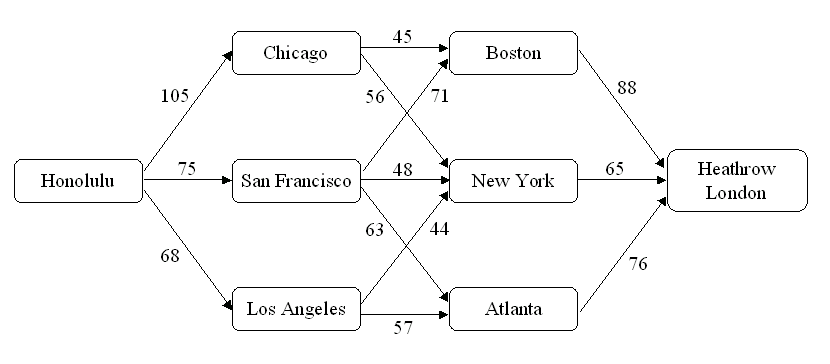| The NETFLOW Procedure |
Example 5.1: Shortest Path Problem
Whole pineapples are served in a restaurant in London. To ensure freshness, the pineapples are purchased in Hawaii and air freighted from Honolulu to Heathrow in London. The network diagram in Figure 5.40 outlines the different routes that the pineapples could take.
The cost to freight a pineapple is known for each arc. You can use PROC NETFLOW to determine what routes should be used to minimize total shipping cost. The shortest path is the least cost path that all pineapples should use. The SHORTPATH option indicates this type of network problem.

|
Figure 5.40: Pineapple Routes: Shortest Path Problem
The SINK= option value HEATHROW LONDON is not a valid SAS variable name so it must be enclosed in single quotes. The TAILNODE list variable is FFROM. Because the name of this variable is not _TAIL_ or _FROM_, the TAILNODE list must be specified in the PROC NETFLOW statement. The HEADNODE list must also be explicitly specified because the variable that belongs to this list does not have the name _HEAD_ or _TO_, but is TTO.
title 'Shortest Path Problem';
title2 'How to get Hawaiian Pineapples to a London Restaurant';
data aircost1;
input ffrom&$13. tto&$15. _cost_ ;
datalines;
Honolulu Chicago 105
Honolulu San Francisco 75
Honolulu Los Angeles 68
Chicago Boston 45
Chicago New York 56
San Francisco Boston 71
San Francisco New York 48
San Francisco Atlanta 63
Los Angeles New York 44
Los Angeles Atlanta 57
Boston Heathrow London 88
New York Heathrow London 65
Atlanta Heathrow London 76
;
proc netflow
shortpath
sourcenode=Honolulu
sinknode='Heathrow London' /* Quotes for embedded blank */
ARCDATA=aircost1
arcout=spath;
tail ffrom;
head tto;
run;
proc print data=spath;
sum _fcost_;
run;
The length at optimality is written to the SAS log as
NOTE: Number of nodes= 8 .
NOTE: Number of arcs= 13 .
NOTE: Number of iterations performed (neglecting any
constraints)= 5 .
NOTE: Of these, 4 were degenerate.
NOTE: Optimum (neglecting any constraints) found.
NOTE: Shortest path= 177 .
NOTE: The data set WORK.SPATH has 13 observations and 13
variables.
The output data set ARCOUT=SPATH in Output 5.1.1 shows that
the best route for the
pineapples is from Honolulu to Los Angeles to
New York to Heathrow London.
Output 5.1.1: ARCOUT=SPATH
Copyright © 2008 by SAS Institute Inc., Cary, NC, USA. All rights reserved.